Top 8 Fitness Exercises for Men Over 40 – Keeping fit is a journey that spans your entire life. Observing individuals in their 40s, 50s, and even 60s who maintain an impressive physique reveals a common factor: a long history of weight lifting. Contrary to popular belief, strength training is not exclusive to the youth; it offers significant benefits to people of all ages, especially with consistent practice. For men in their 40s, incorporating both free weight and bodyweight resistance exercises is crucial. Below are eight key exercises I recommend for all my clients who are 40 and older.
For men in their 40s looking to strengthen their muscles, preserve or enhance muscle mass, and secure a healthy, fit future, including these exercises in your workout regimen is a must. Aim for three sets of each exercise, performing eight to 12 reps. Between sets, rest for 90 seconds, and strive to incorporate these workouts into your routine at least twice a week, or blend them into your existing fitness plan.
Discover the essential exercises for men over 40, and after you’ve learned about these, explore the 5 Best Exercises for Men Over 50 for a Longevity Boost.


Squats are vital for maintaining leg strength, balance, and mobility as you age. They are also beneficial for bone health. This exercise works the quadriceps, hamstrings, glutes, lower back, and core muscles.
To perform a squat, If available, position a barbell at shoulder level on a squat rack, and set the safety pins just above waist level. Stand with your feet shoulder-width apart, and grip the barbell with your hands wider than shoulder-width. Unrack the barbell, and position it across your shoulders. Lower yourself by bending at the knees and hips, pushing through the full foot, and keeping your chest up. Return to the starting position by pushing through the full foot. Repeat for the target repetitions


Lunges improve lower-body strength and flexibility and promote better balance and coordination. They work the quadriceps, hamstrings, glutes, and calf muscles.
To perform a lunge, stand upright with your feet hip-width apart. Step forward with one leg, and lower your body, rotating your back foot inward slightly as you lower the back knee for optimal biomechanics. Keep your torso upright, and ensure your front knee is aligned with your ankle.
Push through the full foot of the front leg to return to the starting position. Repeat for the target repetitions, then switch legs.
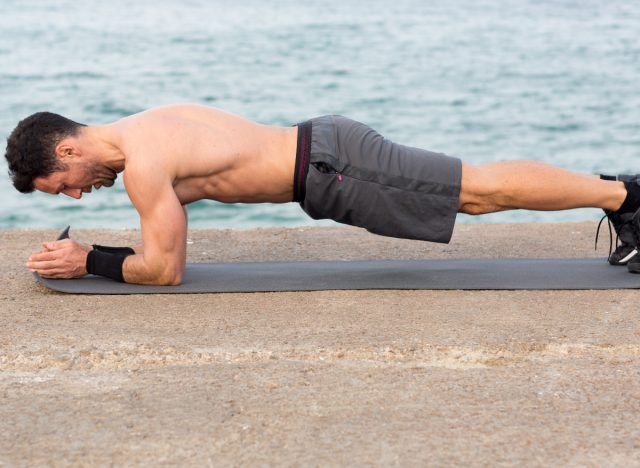

The plank is excellent for core stability and overall strength. It works the abdominals, obliques, lower back, shoulders, and chest.
To perform a plank, start in a forearm plank position with your elbows directly under your shoulders. Engage your core, and maintain a straight line from your head to your heels. Hold this position and breathe, visualizing drawing your lower rib toward your pelvis and engaging your abs. Repeat for the target time.
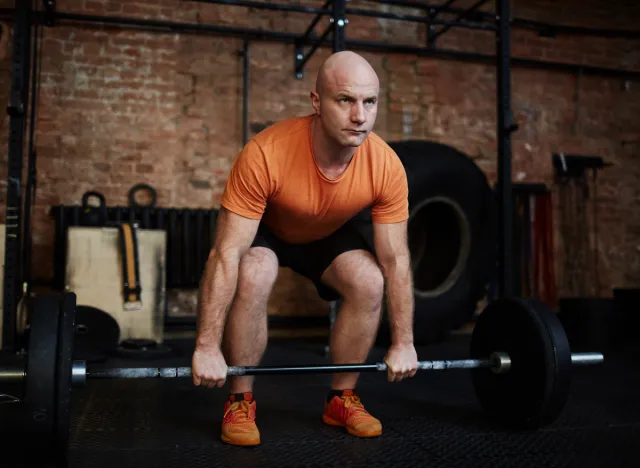

Deadlifts are essential for enhancing overall strength, particularly in the back and legs. They work the glutes, hamstrings, lower back, traps, and forearms.
To perform a deadlift, stand with your feet shoulder-width apart and a barbell in front of you. Bend at the hips and knees to grasp the barbell with both hands. Lift the barbell by straightening your hips and knees, squeezing the end range for about one second, and keeping your back straight. Lower the barbell to the ground by reversing the motion, maintaining control. Repeat for the target repetitions.
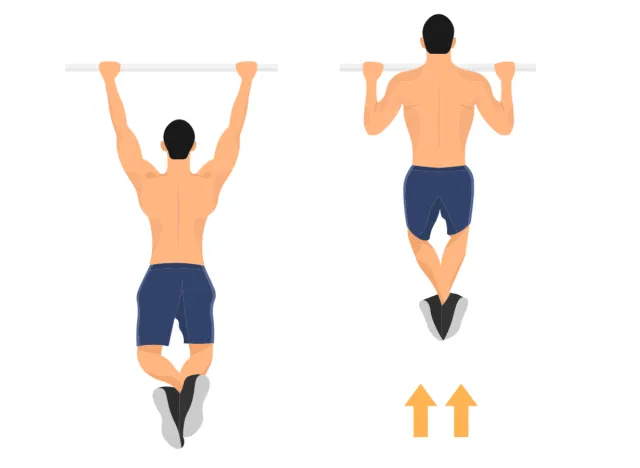

Pull-ups are great for upper-body strength and work the back, biceps, and shoulders.
To perform a pull-up, grip a pull-up bar with your hands wider than shoulder-width. Hang onto it with your arms fully extended and your feet off the ground. Pull yourself up by retracting your shoulder blades and visualizing crushing a piece of fruit in your armpit, squeezing at the end range of motion. Lower yourself to the starting position with control. Repeat for the target repetitions.
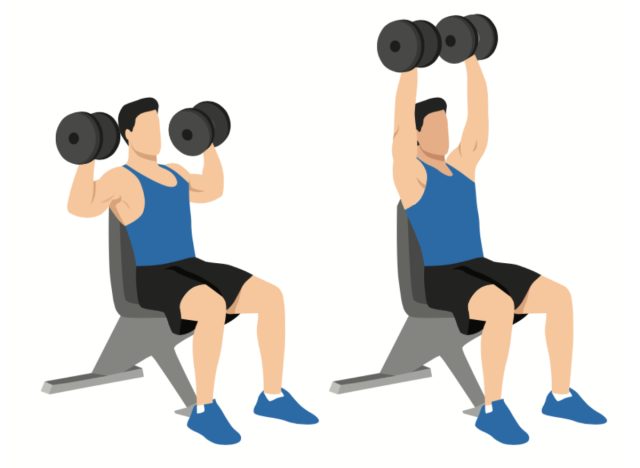

This exercise targets the shoulders, triceps, and upper chest. It’s valuable for maintaining shoulder health and strength.
To perform a dumbbell shoulder press, sit on a bench with back support, holding a dumbbell in each hand at shoulder height. Press the dumbbells overhead, avoiding shrugging throughout the range of motion. Pause at the top, then lower the dumbbells to the starting position. Repeat for the target repetitions.
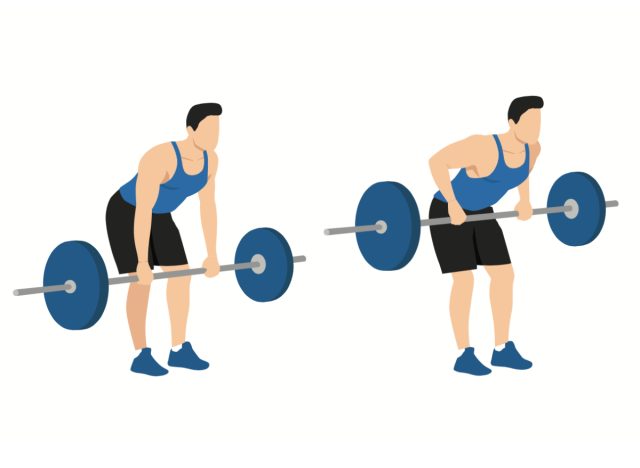

Barbell rows strengthen the back and biceps and improve posture. They work the latissimus dorsi, rhomboids, traps, and biceps.
To perform a barbell row, stand over a barbell with your feet hip-width apart. Bend at the hips and knees, and grasp the barbell with an overhand grip. Pull the barbell toward your lower rib cage, visualizing crushing a piece of fruit in your armpit as you retract your shoulder blades. Lower the barbell with control, avoiding shrugging throughout the range of motion. Repeat for the target repetitions.
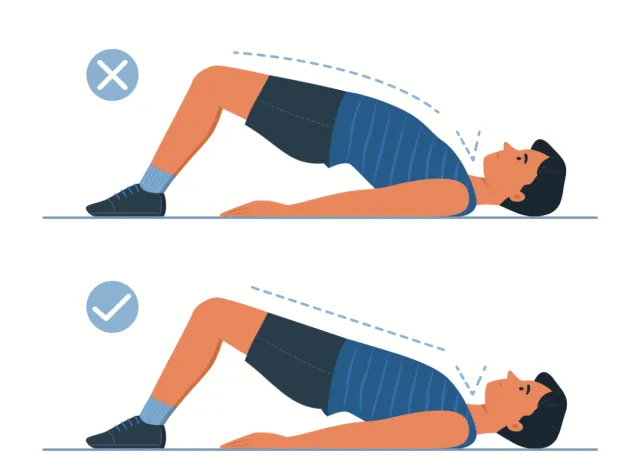

Glute bridges are excellent for lower back and hip health. This exercise works the glutes, hamstrings, and lower back.
To perform a glute bridge, lie on your back with your knees bent and your feet flat on the floor, hip-width apart. Push through the full foot, and lift your hips toward the ceiling, visualizing drawing your lower rib toward your pelvis and engaging your abs. Hold the top position, squeezing the glutes, for about one second. Lower your hips back to the floor with control. Repeat for the target repetitions.
Frequently Asked Questions (FAQs)
1. Why is exercise particularly important for men over 40?
As men age, particularly after the age of 40, changes in metabolism, muscle mass, and flexibility can significantly impact overall health. Regular exercise helps to counter these changes by improving cardiovascular health, maintaining muscle mass, enhancing flexibility, reducing the risk of chronic diseases, and improving mental health.
2. What are the specific benefits of strength training for men over 40?
- Increases muscle mass which naturally declines with age
- Boosts metabolism to aid in weight management
- Enhances bone density, reducing the risk of osteoporosis
- Improves joint flexibility and reduces the risk of injury
- Supports better posture and reduces back pain
3. Can high-intensity exercise be safe for men over 40?
Yes, with proper guidance and a tailored exercise program, high-intensity exercise can be both safe and beneficial for men over 40. It’s crucial to start slowly, prioritize form and technique, and gradually increase intensity. Consulting with a fitness professional or a healthcare provider before starting any high-intensity workout regime is also advisable.
4. How often should men over 40 exercise to see benefits?
The American Heart Association recommends at least 150 minutes of moderate aerobic activity or 75 minutes of vigorous aerobic activity per week for adults, coupled with muscle-strengthening activities on 2 or more days a week. However, the specific frequency and duration can vary based on individual health status and fitness goals.
5. What role does nutrition play in the effectiveness of the exercise regime for men over 40?
Nutrition significantly impacts the effectiveness of any exercise regime, especially for men over 40. A balanced diet rich in lean proteins, whole grains, fruits, vegetables, and healthy fats supports muscle repair and growth, energy levels, and overall health. Proper hydration is also crucial for optimizing performance and recovery.
6. Are there any exercises that should be avoided or modified for men over 40?
While most exercises can be adapted to suit any age, men over 40 should pay particular attention to exercises that place excessive stress on the joints or back. It’s advisable to modify high-impact exercises, such as running or jumping, to lower-impact alternatives like swimming or cycling, and to avoid or modify exercises that can exacerbate any pre-existing conditions.
7. How can men over 40 stay motivated to continue exercising?
- Set realistic and achievable goals
- Track progress through a journal or fitness app
- Mix up the exercise routine to maintain interest
- Find a workout partner or join a fitness group
- Celebrate milestones and rewards for achieving goals
8. Is it necessary to consult a doctor before starting a new exercise program for men over 40?
Yes, it is highly advisable for men over 40, especially those with pre-existing health conditions or who have been inactive, to consult with a healthcare provider before starting any new exercise program. This ensures that the exercise plan is safe and tailored to their specific health needs.

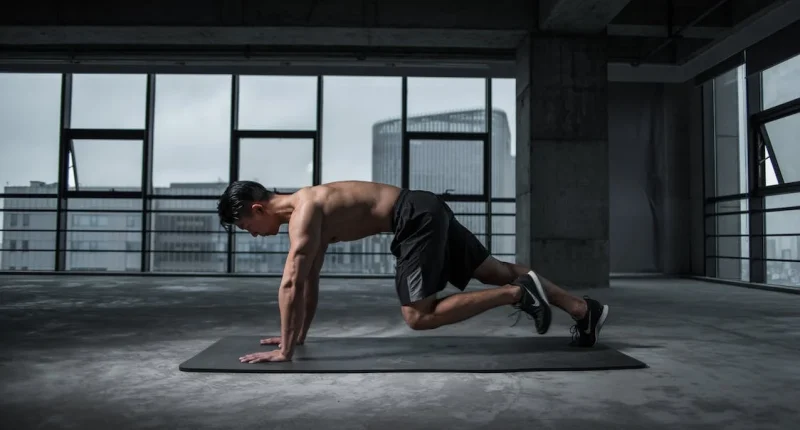





1 comment
Comments are closed.